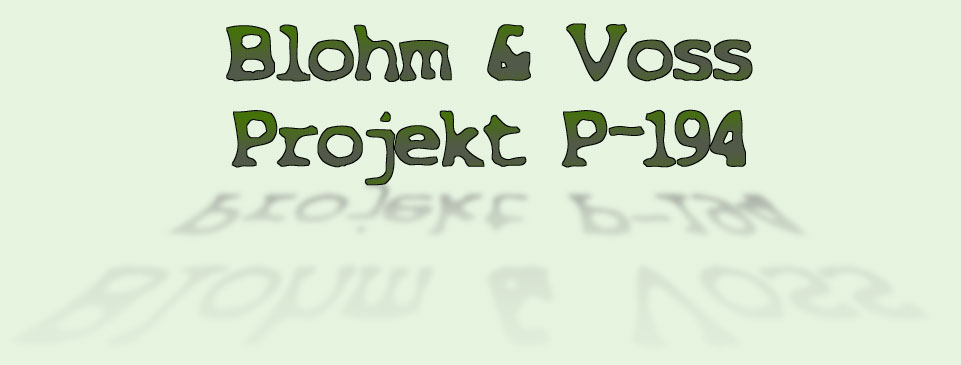History
The Blohm & Voss P194 concept based on an asymmetrical airplane BV 141 proposed already 1937 by Richard Voigt.
The strange shape offered the advantae of having an exceptional visibility, while using just one engine. The RLM was
not particularly convinced considering this somewhat esoteric design, but the BV 141 was cast into hardware,
and the few prototypes showed surprisingly good flight behaviour.
When in 1944 the RLM called for a multi-purpose / ground attack aircraft, BV again pulled out the unusual layout.
Alas, this time amended by a turbojet engine, located below the cockpit. The concept was to use the BMW-801 piston
engine for start and landing operations, which proved the weak point of the Me 262 design. At high altitude the
BMW-003 turbojet would provide an essential performance advantage.
On top of that, the plane was supposed to be built using as little strategically important materials as possible, so major
part of the structure was made to be built of steel. The complete front of the gondola was supposed to be constructed
of armour plates. While these considerations held some promise, the effects of the assymetrical layout on
controllability of this heavy aircraft after failure of one of the engines provided significant risk. Also the location of the jet intake
close to the wheel invites foreing object damage. Since the times did not permit any validation of the concept, it will
stay another Luft'46 mystery.
|


|
The kit
I bought Revell's re-boxing of a kit from the nineties. While being over a decade old, the kit is still up to date.
Revell did a good job on the design of a series of Luft'46 models back then, which now again sell for a couple
of Euros at every department store or supermarket.
The kit comes with two sprues in gray styrene, and another one in clear. The quality is good, no flash, offset, sink holes
or such. The clear parts are without blurrs, and acceptably thin.
The decals are thin, with good register, and feature markings for two fictive airplaes on the eastern front in 1946.
One disadvantage is Revell's typical floppy single-piece box, which is annoying, if the parts need to be stored away
during the build process.
|
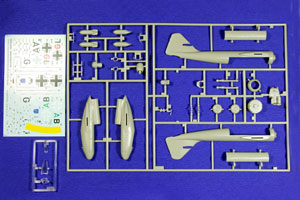
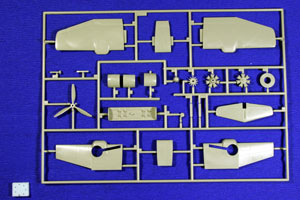
|
The build
I started this project as a diversion, because my main project was just driving me crazy.
The build itself was rather simple. The parts are fitting well, so it was really a good cure against modelling frustration.
Starting by the gondola, I added the seat belts, and some levers in the cockpit. The instruments are
embossed on the panels, which may produce nice results, if the proposed decals also fit the shape of the plastic.
Since they don't, I cut out the single instruments, and tried to locate them properly on the instrument board.
The window at the front of the gondola requires the painting of the complete cockpit area.
Here the wings, the gondola and the fuselage main section as well as the rudders had to be assembled.
I modified somewhat the building sequence, by first painting the inside areas (wheel well, bomb bay, doors, etc.) green.
These had then to be masked with Tamiya tape. Next step was Mr. Surfacer. No putty beyond that was necessary,
and grinding of the seams was just very light. Afterwards, a light pre-shading was applied with black Tamiya paint.
I decided to go for a different scheme, than shown on the instruction: I selected the scheme proposed by Peter Allen on
Aeroscale. I used RLM76 for the bottom. Side and top got RLM 83, with RLM82 squiggles, all in Xtracolor enamel.
(My wife instantenously nicknamed this camo pattern "the tiger-frog"). The initial coating got a seal of Future on top.
The model offers the possibility to show the BMW-801 with open cowling, which I wanted to use. The engine itself is
unfortunately not well detailed, and can be mostly seen from the side. I added fuel lines, and some structure on the
cylinder heads, to make it at least roughly resemble the real thing. The exhaust pipes on the rear side of the engine
assembly were drilled out. The exhaust nozzle of the jet was airbrushed using Alclad.
The spinner got a nice spiral, which unfortunately proved to be twisted the wrong way around, so I re-did it in yellow.
It was attached to the main and the cooling propellers, and equipped with an axis made from a needle. The bearing was prepared the
usual way - by drilling out a short segment of a sprue. Then a counterhole was drilled in the engine body, which will
later accomodate the bearing of the free spinning prop assembly by a gentle press-fit.
The bombs got a painting with dark green, and a mechanic's greetings to the enemy. I took the libert to write them in
Süterlin, the old german hand-writing. According to Revell's instruction, the bomb bay doors were supposed to slide
below each other. I could not imagine, how this was supposed to work, so I refrained to a solution like seen on the TBD Avenger,
where the doors just fold. To round it off, each of the doors got a hydraulic actuator.
The landing gear was amended with a brake line, and a metal pin for the actuator. According to the instuction, the clamp of the
oleo was supposed to point backwards, but in that case, it would obstruct the retraction of the wheel leg. I assembled it pointing outwards.
The decals were applied, and adhered nicely with a setting solution. A this point, the model was washed with thinned artist oils.
Unfortunately, haste was punished again: I wanted to finish the model before the first model show this year, and didn't seal off the
base coat properly. As a result, I washed off some of the squiggles, and had to correct them significantly afterwards.
The smoke trails behind the engine and the guns were sprayed-on using Tamiya smoke. Finally, the model was coated with the proven
Xtracolor flat varnish.
In the end, the canopy was assembled: the front rounded was faired with a thin stripe of lead foil, the rear part got two rails,
and a hydraulic cylinder. The last finishing touches were the pitot tube, the gun barrels in the nose and the position lights.
|
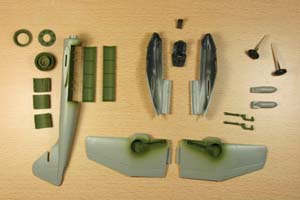
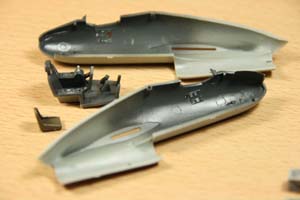
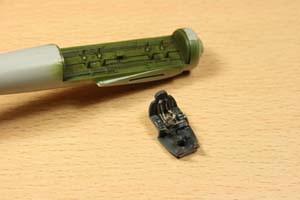

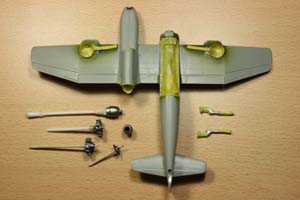
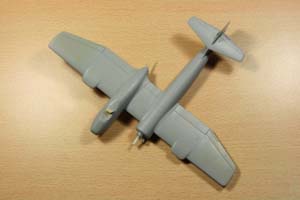
|
